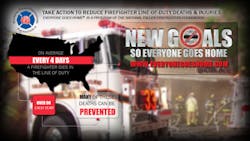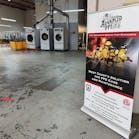The 'Thinking Firefighter' is More Than Bravery and Strength
Editor’s note: Discuss survivability, thermal assault and the NFFF’s New Goals initiative to reduce firefighter line-of-duty deaths to under 50 annually in the following Firehouse.com Forums:
- What does the term “thinking firefighter” mean to you?
- What’s one thing your crew is doing differently as a result of new fire behavior research or data, such as the studies coming out of UL/NIST?
And find more information on the NFFF’s New Goals initiative at www.everyonegoeshome.com.
In his June Firehouse magazine article, Ron Siarnicki writes about the concept of “thermal assault”—the combination of factors contributing to increased risk on the fireground. As Ron notes, much of this increased risk is due to our tendency to cling to a mindset of suppression through aggression—the idea that we must pursue the fire, we must go inside, we must push further, we must go where it’s hotter. Yet fire behavior studies done by the National Institute of Standards and Technology (NIST) and UL are challenging this mindset by scientifically proving that many of our tactics, from certain types of ventilation to going interior whenever possible, are in fact not the fastest, most effective way to suppress the fire and make conditions more tenable for possible victims.
In the space of this one short article, I’m not going to try to tackle a summary of the research that NIST and UL have done, or what it means for our tactics. I do, however, want to explore one of the terms that has come out of this research, one you may have seen being passed around on social media: “thinking firefighter.”
What does it mean to be a thinking firefighter? Obviously, firefighters have always used their intelligence when fighting fires; our forefathers were not simply brave, they also carried with them stores of knowledge about building construction, fire behavior, tool use and even human nature.
At the same time, however, there is no escaping that the fire service is a paramilitary organization. We train recruits to respect the chain of command and we use repetition to build muscle memory, performing the critical tasks of tapping hydrants, throwing ladders, advancing hose, over and over again so that when seconds count, we have some slim margin of advantage over the fire. We focus on keeping our bodies in shape so we can pull ceilings, drag hose, work saws at odd angles from the roof or the ladder and—maybe, someday—rescue a victim from the throes of fire.
We are, in short, masters of the standard operating procedure. But we do a far less effective job of training our brains to effectively, accurately, quickly read situations, identify anomalies and adjust tactics accordingly. And we have not fostered a culture of open-minded consideration of new research and transformative technologies. Quite frankly, many of us feel threatened when evidence challenges the effectiveness of traditional tactics.
But a thinking firefighter does not. A thinking firefighter not only understand the SOPs and reads the texts of those who fought fire long before us, but also studies the latest research and completes online training programs built to disseminate this new knowledge. A thinking firefighter uses training to test the effectiveness of tactics, and makes changes when needed. A thinking firefighter arrives on scene looking for indications of risk in the built environment, considering that even in older homes, today’s fuel loads can create flashover conditions within minutes. A thinking firefighter knows that smoke is fuel, and considers flow paths before venting. A thinking firefighter understands the importance of door control. A thinking firefighter looks for the fastest way to get water on the fire—even when that involves a knock down from the outside.
Again, the concept of the “thinking firefighter” is not new. In fact a classic example comes to us from the fire service legend Alan Brunacini and the response he led to the line-of-duty death of Brett Tarver. At the time, rapid intervention teams were largely static and limited to one company (or two firefighters, following two-in/two-out). But Tarver’s tragic death provided the first hint that RIT, as conceived, might not be effective. Bruno’s reaction to this death wasn’t to chalk it up to a freak incident or something that couldn’t be prevented. Instead, his crews relentlessly tested their RIT response, and in so doing, discovered that it took 20 minutes and 12 firefighters to rescue a downed firefighter. That finding turned our RIT and Mayday procedures upside down, and because the department so willingly shared their data, led to dramatic changes in the way we approach rapid intervention today.
That’s the work of thinking firefighters. And it’s not that different from the work currently being done by Steve Kerber, Dan Madrzykowski and many others, who are painstakingly building test structures that duplicate the conditions we face on the fireground, and rigorously—without emotion or bias—demonstrating what tactics make the environment most tenable for potential victims and firefighters.
So no, the concept of a thinking firefighter isn’t new, and it’s not all that radical. But it’s never been more important. Brute strength, bravery and aggressiveness are no longer enough to succeed on the modern fireground. Even the knowledge we store up from our own experiences is insufficient, because it is prone to bias and limited to our perspective—and it goes untested. When we make a knockdown through traditional venting and interior attack, it appears to reinforce the validity of those traditional tactics. But in fact other methods may have been much more successful, resulting in faster knockdown with less property damage and—most importantly—less risk to the crew. We must learn from those who are using research to expose our weaknesses and test new methods that will keep us safer. We can’t all work for NIST or UL, but we can all learn from the information they so willingly share.
The National Fallen Firefighters Foundation’s “New Goals” campaign is an effort to bring LODDs to less than 50 annually. It’s a lofty goal, and one that won’t be achieved by following our standard way of operating. Are you ready to join the movement, and become a thinking firefighter?
TIMOTHY E. SENDELBACH is the Editor-in-Chief for Firehouse. A 29-year student and educator of the fire and emergency services, he is responsible for the content and editorial direction of Firehouse® Magazine, Firehouse.com, Firehouse Expo, Firehouse World and related products. He has served as an assistant fire chief with the North Las Vegas, NV, Fire Department, as the chief of training for Savannah, GA, Fire & Emergency Services and as assistant fire chief for Missouri City, TX, Fire & Rescue Services. He is a credentialed Chief Fire Officer and Chief Training Officer and has earned a master’s degree in leadership from Bellevue University, bachelor’s degrees in fire administration and arson and an associate’s degree in emergency medical care from Eastern Kentucky University. You can e-mail him at [email protected].






